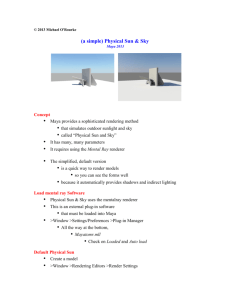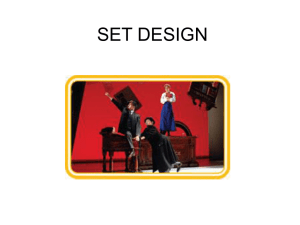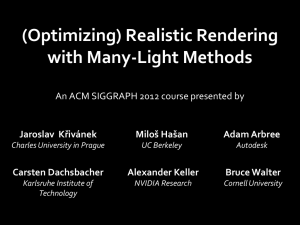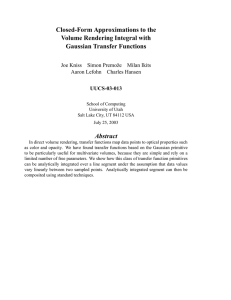Image Based Rendering Render from images
advertisement
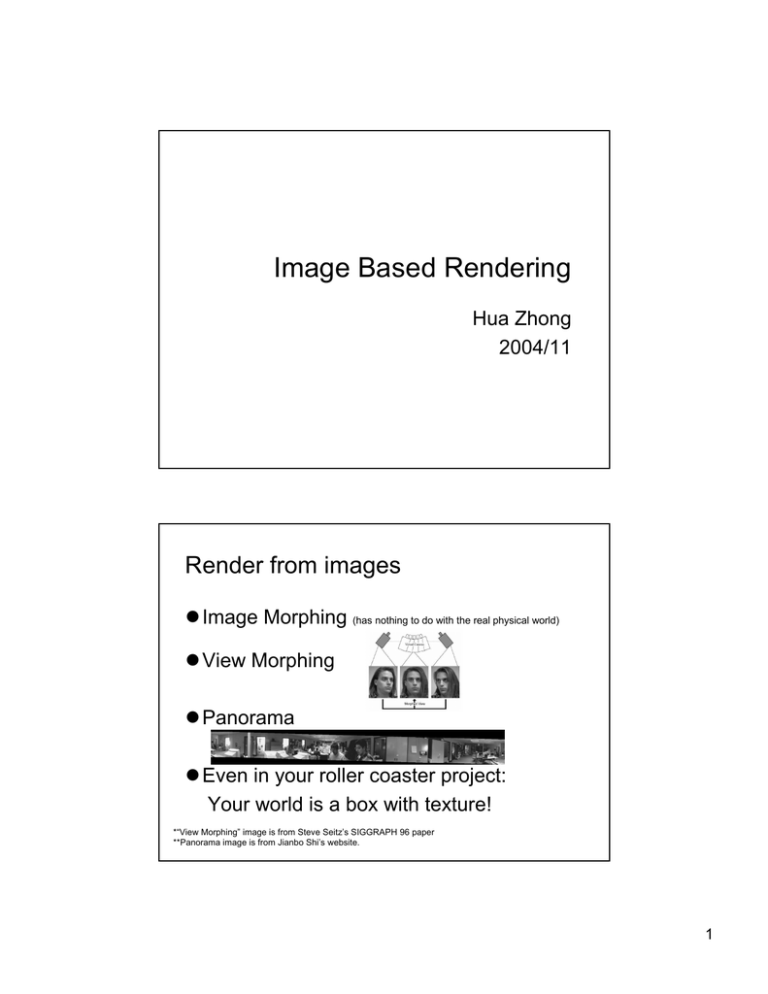
Image Based Rendering Hua Zhong 2004/11 Render from images Image Morphing (has nothing to do with the real physical world) View Morphing Panorama Even in your roller coaster project: Your world is a box with texture! *“View Morphing” image is from Steve Seitz’s SIGGRAPH 96 paper **Panorama image is from Jianbo Shi’s website. 1 But what is image based rendering? What is the fundamental idea of image based rendering? Why we want to do that? Why it works? (in some cases) How to do that? … A Rendering task: A Programmer’s Desk 2 A Rendering task: A Programmer’s Desk A Phone. Black, Plastic, Solid and Opaque Surface A Rendering task: A Programmer’s Desk A Robot! Well model this could be a little bit complex, but still doable, there is only one, right? 3 A Rendering task: A Programmer’s Desk A transparent cube with a statue of liberty inside it! A Rendering task: A Programmer’s Desk Half transparent objects, non-regular shape, different materials (labels) on the object. 4 A Rendering task: A Programmer’s Desk A fuzzy toy full of fur all over it and a piece of cloth. Special materials. A Rendering task: A Programmer’s Desk With a lot of other things together, and we need global illuminations!! 5 A Rendering task: A Programmer’s Desk Render it in Real-time!! With a lot of other things together, and we need global illuminations!! Start from Ray Tracing 6 Sample the ray space Sample Rays by Taking Pictures! 7 Ray Space Dimension? How to parameterize it? Then how to sample it? Light Field: Ray Space Representation Two-plane parameterization of ray space Marc Levoy and Pat Hanrahan. Light field rendering. In Proceedings of SIGGRAPH '96 Image is from Marc Levoy and Pat Hanrahan’s Siggraph 96 slides. 8 Light Field: Sampling Scheme S,T plane U,V plane Light Field: Render S,T plane U,V plane 9 A Simple Demo I wrote this simple LF demo. Samples on ST plane: 200x200 Samples on UV plane: 21x21 Rendering is in 200x200 Overview of the whole Light Field Two-plane ray space parameterization Sample scheme for UV,ST Interpolating rays to render novel views Don’t need to model anything: surface model, volumetric model, lighting model, surface property model… NOTHING but ray space model. 10 Difference from conventional graphics pipeline No model Sampling and Synthesis (render) approach And is it perfect? No 11 Light Field is one basic IBR technique There are a lot of more others They all share the “sampling-rendering” scheme They only differ in how to sample, and how to render. Panorama S. E. Chen. Quicktime VR --- An imagebased approach to virtual environment navigation. In Proc. SIGGRAPH 95 http://www.worldserver.com/turk/quicktimevr/SanctusFrancisco1.html 12 Concentric Mosaic H.-Y. Shum and L.-W. He. Rendering with concentric mosaics. SIGGRAPH, pages 299--306, August 1999 Surface Lightfield D. Wood, D. Azuma, K. Aldinger, B. Curless, T. Duchamp, D. Salesin, and W. Stuetzle. Surface Light Fields for 3D Photography. In Proc. SIGGRAPH, pages 287--296, July 2000 13 Plenoptic Sampling J. X. Chai, X. Tong, S. C. Chan, and H. Y. Shum, "Plenoptic Sampling," in SIGGRAPH Conf. Proc., 2000, pp. 307-318 Motion Pictures, Animations! All those techniques are only good for static objects. 3D 3D+time = 4D motion pictures Remember Matrix? 14 Effects in Matrix New Light Field Hardware Stanford people built this recently 15 Similar hardware CMU people built this a long time ago: Virtualized Reality EyeVision demo in Superbowl 2001 What can be done in the future? Better compression Combine IBR with geometry Cheaper hardware 16 Conclusion A different approach to render scenes: sample and synthesis. Can deal with very complex scenes without modeling it, super realistic, because it is real. Have to save a lot of samples, but for movies, that’s ok. For games, maybe not. 17

